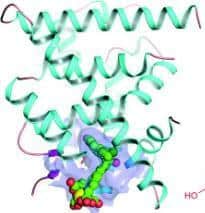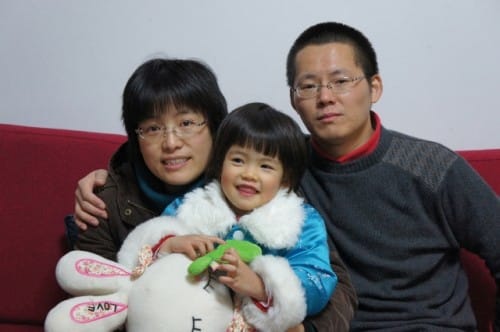It all started with research carried out by Prof. Yoel Sussman from the Weizmann Institute at the Shanghai Institute of Materia Medica, and continued by inviting two researchers - research partners at the Weizmann Institute

When Yichun Xue first held her daughter Yu-yang, she was full of joy and hope - like all mothers in the world. Her husband, Mingjun Lee, who was standing by her side, was also happy. The only thing they lacked at that moment was the participation of their family members, whom they left behind in their home country, China, in their joy. The medical staff at Kaplan Hospital tried very hard to make them feel at home, as did their friends and colleagues from Prof. Yoel Sussman's laboratory at the Weizmann Institute of Science, who did their best to fulfill the role of the extended family. "I felt almost like a grandfather when Yu-Young was born," says Prof. Sussman, from the structural biology department at the institute.
Prof. Sussman and Weichun Xue had gotten to know each other several years before, at the "Shanghai Institute of Medical Umbrella", a research institute of the Chinese Academy of Sciences, where she studied for a Ph.D. Prof. Sussman and his colleague from the institute, Prof. Israel Silman, carried out joint research with Yichun's supervisors at the Shanghai Institute, which dealt with an herb extract used as a medicine in traditional Chinese medicine. Following this, after Yichon received her doctorate in July 2005, Prof. Sussman and Prof. Silman invited her to do post-doctoral research at the Weizmann Institute of Science.
Before arriving in Israel, Yichun separated from her husband, engineer Minjun Lee. The couple met each other when they were both studying for a bachelor's degree in chemistry at East China University in Shanghai. After receiving his degree, Minjun Lee began working for an international company specializing in magnetic resonance equipment, and at some point decided to go study abroad as well. He left his job, and began doctoral studies at the University of Texas.
A detailed three-dimensional structure of a cluster that includes the molecular marker (bottom) and the binding site of the estrogen receptor. The saber was designed with the aim of identifying the receptor, as part of an improved method for breast cancer diagnosis and treatment
Shortly after his arrival in the US, Minjon heard from his wife about the success of her research at the Weizmann Institute - which involved deciphering the three-dimensional structure of an enzyme involved in the formation of protein deposits in the brain, characteristic of Alzheimer's disease - and about the excellent research conditions at the institute. Later, Yichun wrote to him that an opportunity had arisen for him to participate in a fascinating research project at the institute, as a PhD research student. It so happened that in the summer of 2006, after about a year in Houston, Minjon joined his wife in Rehovot.

Minjon's doctoral research focused on a small molecule, which one day may be able to help in the treatment of breast cancer and other diseases involving estrogen hormone receptors, as well as in the diagnosis of these diseases - using methods based on magnetic resonance imaging. The results of the research, under the joint guidance of Prof. Sussman and Prof. Hadassah Dagani from the Department of Biological Control at the Institute, were published in the scientific journal Journal of Medicinal Chemistry.
Mingjun, who recently returned to Shanghai, said that he was particularly impressed by the possibility offered by the Weizmann Institute to conduct interdisciplinary research. "The atmosphere at the institute is open and informal, and it encourages collaboration, because it is easy to communicate with people from different laboratories and departments." Particularly important to him were the consultations with the institute's scientists involved in the creation of the Proteopedia - a collaborative three-dimensional encyclopedia of proteins and other molecules, developed at the Israel Center for Structural Proteomics at the Weizmann Institute of Science.
During their stay in Israel, Mingjun Vichon spent most of their time at the institute, and enjoyed the quiet environment on campus, which allowed them to focus on research. On weekends, they used to visit historical sites and travel around the country, and especially the Dead Sea - which all Chinese students learn about in high school. On one occasion Minjun organized a meeting for several dozen Chinese students from research institutes and universities in Israel, which took place at the institute.
In March 2009, Yichun gave birth to Yu-Yang, known as Yu-Yu, and a few months later returned to Shanghai with her little daughter, to establish her own laboratory at the "Shanghai Medical Umbrella Institute". Minjun will stay at the institute until he finishes his doctoral thesis, at the end of 2011. He plans to look for a job in one of the branches recently opened in China by international pharmaceutical companies.
The young Chinese couple enjoyed the warm attitude of their instructors from the institute, who invited them to their home often. "They were more like parents to us than bosses," Minjon says.
